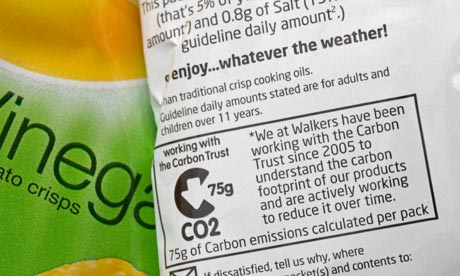
Carbon labelling – putting information on products about the amount of carbon used to manufacture them – is a big idea that has never taken off. Despite their potential to make a significant impact on how people make choices about what (or even if) they buy, carbon labels have only ever appeared on a very small number of items.
So why has carbon labelling never got off the ground? One major problem is that calculating the carbon emissions of any given product is fiendishly difficult. Even something as seemingly straightforward as the production of vegetables involves many stages. Tracing and measuring the carbon impact of getting a potato from the field to your plate is tricky enough, let alone something as complex as a plasma TV. Cars are increasingly marketed in the UK on the basis of their carbon emissions – although this relates to the efficiency of the engine on the road, not the amount of energy required to build the car in the first place.
And then there is the issue of how to display carbon information. Unsurprisingly, research has found that most people don't have any idea what 10g or 25kg or carbon means – so simply scrawling numbers on the front of products is not necessarily helpful.
As well as the practical issues of how to measure, calculate and display carbon information, there is a great deal of confusion among the general public about what carbon labels are supposed to mean.
Recent research commissioned by the UK government identified a problem that most people will have had some experience of: the profound meaninglessness of many "green" claims on products. Between the self-evident sustainability of local, seasonal produce and the more obvious attempts at greenwash propagated by the aviation industry, there is a huge amount of ambiguity over green terms. Most people have real difficulty distinguishing genuine steps towards sustainable manufacturing from spurious symbols that indicate nothing of any substance.
But even more systematic attempts at measuring carbon – such as the small number of companies taking part in the Carbon Trust labelling scheme – are rendered almost meaningless without more products to compare them to. As research by the Tyndall Centre has shown, claims about carbon reduction make little sense out of context. The Tyndall researchers calculated that it would take 32 years' worth of daily purchases of "lower carbon" Tesco orange juice to save the same amount of carbon as avoiding just one return flight from the UK to Spain.
But these obstacles to communicating carbon make a simple, universal label all the more urgent. The "soft" green labels that currently operate in the place of carbon labelling are often impossible to regulate – precisely because they are so vague and meaningless. The word "sustainable" can be attached to almost anything, but when eco-labels are attached to everything from bottled water to bank accounts, it is difficult to pick a green product from a red herring.
There are ways of presenting carbon information that are more palatable than a barrage of numbers – for example, traffic-light systems that indicate when a product is low, medium or high carbon relative to its immediate competitors. And the limited amount of research so far suggests that indicating when a product is best in class is much more informative than providing a numerical estimate.
Another big idea for sustainable consumption, personal carbon allowances, would require an explicit carbon value to be attached to products. The prospect of individual carbon budgets may seem an even more distant possibility than carbon labelling, but one without the other would make little sense. So in the long run, some kind of carbon labelling seems inevitable.
In the same way that products cannot make misleading claims about their functionality, there would need to be advertising standards for carbon labelling. It is misleading to label a luxury product (eg strawberries in mid-winter) as "low carbon", even though they may accurately be described in this way when compared to their competitors.
Getting to grips with carbon labelling is an unenviable challenge, and simply providing carbon information is not a panacea for sustainable consumption. But it is a minimum requirement if people are expected to make choices between the otherwise impenetrable green claims of competing brands and products.
Adam Corner is a research associate at Cardiff University. His interests include the psychology of communicating climate change.
This content is brought to you by Guardian Professional. Become a GSB member to get more stories like this direct to your inbox







